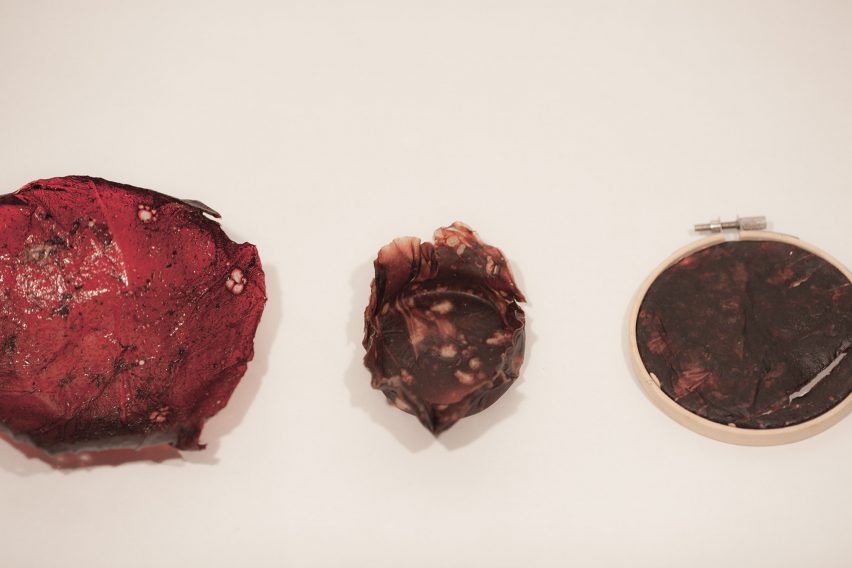
Shahar Livne makes bio-leather shoes from slaughterhouse waste
Israeli designer Shahar Livne has designed a pair of sneakers with alternative leather inserts made from the wasted fat, bones and blood of animals.
The Blood Sneakers were designed as part of Livne's Meat Factory project. It sees her run a series of material experiments to turn fat and bones taken from waste streams of slaughterhouses in the Netherlands into a sustainable material.
Inspired by the "nose to tail" attitude of using the entire animal, Livne also used discarded blood as an ink-like colourant and plasticiser for the deep-red material.

While the ingredients and their amounts are under wraps, the designer uses the waste products to form a substance that can then be moulded or 3D-printed into a leather-like material, or extruded into yarn.
The Design Academy Eindhoven graduate hopes her project will spark conversations around the lack of knowledge consumers have about where the food on their plate comes from.
"The Meat Factory project investigates the dissonance people have with the food on their plates and the living animal, and the psychological dissonance between raw materials and processed materials," the designer explained.
"It explores the emotional connection with nature that has changed since food and materials became industrialised, and consumers have been alienated from the source, content and use of animal-based materials," she added.

While the main body of the trainers are made from Nappa leather, each shoe features a dark red panel at its centre of a material that the designer describes as bio-leather, as a hint towards the potential of the material as an alternative to leather.
Made in collaboration with sustainable luxury footwear brand Nat-2, the outsoles of the sneakers are made from rubber, while the insoles are made from cork.
Livne hopes to develop her bio-leather material to a point where it could be used to make the entire shoe in the future.

"With these sneakers we want to bring more attention to urgent international matters such as sustainability in different animal-based industries by using nature-given resources and upcycling leftovers from those industries," said Nat-2 and Livne.
"But we also want to make a point for more tolerance and open-minded thinking by raising people's fascination and curiosity, and highlighting the wasteful and disrespectful treatment of animals and natural resources," they added.
Livne also hopes her project will bring to light the "misleading" view that leather is a by-product of the meat industry.

"The hide is what comes out of the slaughterhouses, and to become leather it needs to go through processes that involve chemicals or a lot of energy and water," she explained.
"If leather is sourced from a cow's hide it is usually scratched or damaged by insects, which leads tanneries to cut out those parts or refine them extensively," Livne continued.
"On the other hand, you have luxury calfskin for high-end fashion – in which case the calves, or other animals, are grown for their flawless skin."
"This bio-leather offers a new, out-of-the-box possibility that utilises animal by-products that are low in cost and pollution, and that mitigate the amount of waste created by meat-production industries," she added.
Livne previously created a range of sculptural objects from a clay-like material made from discarded plastic.
The designer hopes her Lithoplast material will challenge the idea that petroleum-based plastics are damaging the planet by treating their waste as a valuable commodity for future generations.